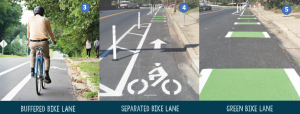How often has a family member or friend complained that they didn’t know how to deal with bikers and bike lanes when driving? What seems second nature to bikers can be confusing to motorists.
We are fortunate that Fairfax County continues to add various types of bike lanes to connect people to neighborhoods, shopping, public transportation, and jobs. But the range of bike lanes in the county does not it make it easier for motorists to know what to do. So, please help your friends and family and share the following information courtesy of the Fairfax County Department of Transportation.

Sharrow: Shared lane markings (photo 1) indicate a shared travel lane for bicycles and cars. Motorists may legally cross the double yellow line in order to safely pass a person riding a bicycle as long as the oncoming lane is clear.
Bike Lanes: Bike lanes come in four styles but each give bicycles and cars their own spaces, making it safer to motorists to pass legally or to continue unimpeded in their lane.
- For standard bike lanes (photo 2), motorists should stay outside the bike lane except when making a right turn. Motorists, after checking to see the lane is clear and yielding to bicyclists, can then merge into the bike lane to make the right turn.
- Buffered bike lanes (photo 3) provide additional space between bicycles and cars. The extra space is intended to cyclists and drivers more comfortable and confident. Motorist should not drive or park in the painted buffer or in the buffered bike lane.
- Separated bike lanes (photo 4) are divided from regular travel lanes by physical barriers. As with buffered lanes, motorists should not drive or park in the bike lane. Drivers also should watch for cyclists and use caution when making a right turn.
- Green bike lanes (photo 5) features painted green pavement to highlight areas where people driving and cycling should pay extra attention. Green pavement is usually used at locations where drivers need to cross over the bike lane. Motorists still need to yield to bicyclists when crossing the green bike lane.

Tell your motorist friends that, where there are no bike lanes, cyclists are required to ride as far to the right of the road as safely practicable but that they may take the full lane if safety requires it. Also, if bike lanes are unsafe due to debris, snow, or obstacles such as trash cans, bikers may choose not to use the bike lanes and ride in the road.
